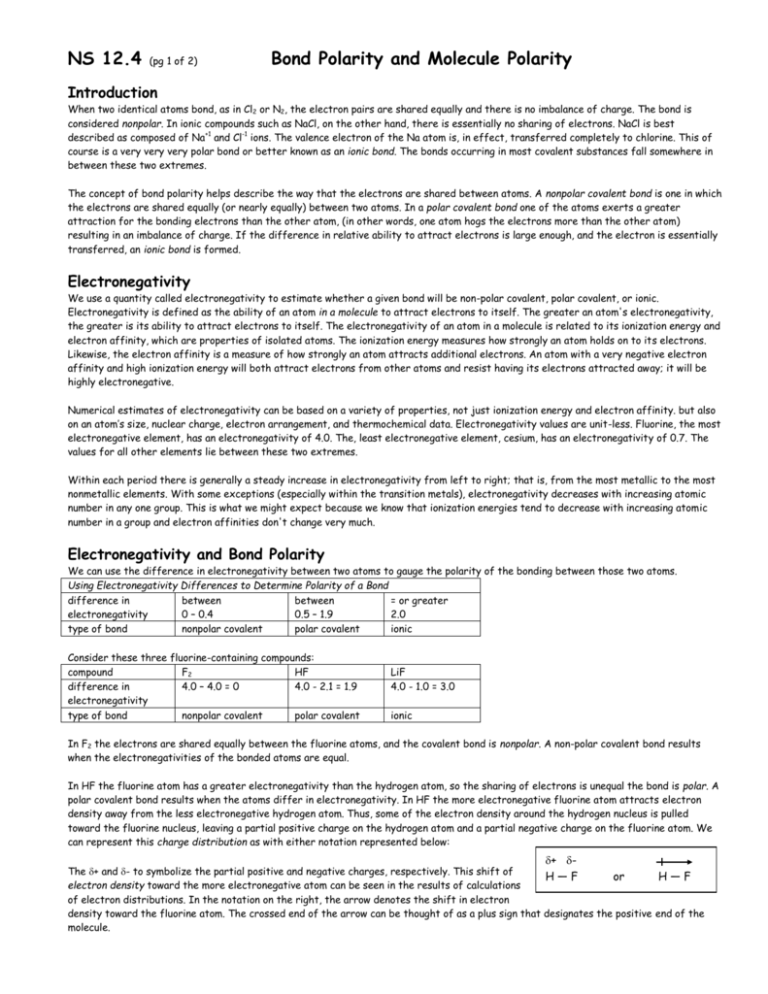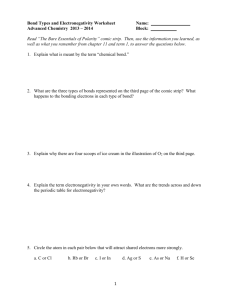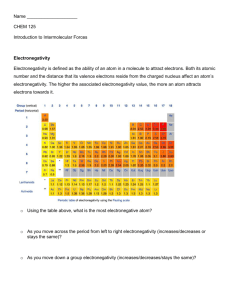NS 12.4 Polarity
advertisement

NS 12.4 (pg 1 of 2) Bond Polarity and Molecule Polarity Introduction When two identical atoms bond, as in Cl2 or N2, the electron pairs are shared equally and there is no imbalance of charge. The bond is considered nonpolar. In ionic compounds such as NaCl, on the other hand, there is essentially no sharing of electrons. NaCl is best described as composed of Na+1 and Cl-1 ions. The valence electron of the Na atom is, in effect, transferred completely to chlorine. This of course is a very very very polar bond or better known as an ionic bond. The bonds occurring in most covalent substances fall somewhere in between these two extremes. The concept of bond polarity helps describe the way that the electrons are shared between atoms. A nonpolar covalent bond is one in which the electrons are shared equally (or nearly equally) between two atoms. In a polar covalent bond one of the atoms exerts a greater attraction for the bonding electrons than the other atom, (in other words, one atom hogs the electrons more than the other atom) resulting in an imbalance of charge. If the difference in relative ability to attract electrons is large enough, and the electron is essentially transferred, an ionic bond is formed. Electronegativity We use a quantity called electronegativity to estimate whether a given bond will be non-polar covalent, polar covalent, or ionic. Electronegativity is defined as the ability of an atom in a molecule to attract electrons to itself. The greater an atom's electronegativity, the greater is its ability to attract electrons to itself. The electronegativity of an atom in a molecule is related to its ionization energy and electron affinity, which are properties of isolated atoms. The ionization energy measures how strongly an atom holds on to its electrons. Likewise, the electron affinity is a measure of how strongly an atom attracts additional electrons. An atom with a very negative electron affinity and high ionization energy will both attract electrons from other atoms and resist having its electrons attracted away; it will be highly electronegative. Numerical estimates of electronegativity can be based on a variety of properties, not just ionization energy and electron affinity. but also on an atom’s size, nuclear charge, electron arrangement, and thermochemical data. Electronegativity values are unit-less. Fluorine, the most electronegative element, has an electronegativity of 4.0. The, least electronegative element, cesium, has an electronegativity of 0.7. The values for all other elements lie between these two extremes. Within each period there is generally a steady increase in electronegativity from left to right; that is, from the most metallic to the most nonmetallic elements. With some exceptions (especially within the transition metals), electronegativity decreases with increasing atomic number in any one group. This is what we might expect because we know that ionization energies tend to decrease with increasing atomic number in a group and electron affinities don't change very much. Electronegativity and Bond Polarity We can use the difference in electronegativity between two atoms to gauge the polarity of the bonding between those two atoms. Using Electronegativity Differences to Determine Polarity of a Bond difference in between between = or greater electronegativity 0 – 0.4 0.5 – 1.9 2.0 type of bond nonpolar covalent polar covalent ionic Consider these three fluorine-containing compounds: compound F2 HF difference in 4.0 – 4.0 = 0 4.0 - 2.1 = 1.9 electronegativity type of bond nonpolar covalent polar covalent LiF 4.0 - 1.0 = 3.0 ionic In F2 the electrons are shared equally between the fluorine atoms, and the covalent bond is nonpolar. A non-polar covalent bond results when the electronegativities of the bonded atoms are equal. In HF the fluorine atom has a greater electronegativity than the hydrogen atom, so the sharing of electrons is unequal the bond is polar. A polar covalent bond results when the atoms differ in electronegativity. In HF the more electronegative fluorine atom attracts electron density away from the less electronegative hydrogen atom. Thus, some of the electron density around the hydrogen nucleus is pulled toward the fluorine nucleus, leaving a partial positive charge on the hydrogen atom and a partial negative charge on the fluorine atom. We can represent this charge distribution as with either notation represented below: + - The + and - to symbolize the partial positive and negative charges, respectively. This shift of H—F or H—F electron density toward the more electronegative atom can be seen in the results of calculations of electron distributions. In the notation on the right, the arrow denotes the shift in electron density toward the fluorine atom. The crossed end of the arrow can be thought of as a plus sign that designates the positive end of the molecule. NS 12.4 (pg 2 of 2) Bond Polarity and Molecule Polarity In the picture below the blue represents low electron density and the red represents high electron density. The difference in electronegativity between H and F leads to a polar covalent bond in the HF molecule. As a consequence, there is a concentration of negative charge on the more electronegative F atom, leaving 2 the less electronegative H atom at the positive end of the molecule. A molecule such as HF in which the centers of positive and negative charge are imbalanced is said to be a polar molecule. Thus, we not only describe bonds as polar and nonpolar, but also entire molecules are described as such. F HF LiF Polarity helps determine many of the properties of substances that we observe at the macroscopic level, in the laboratory and in everyday life. Polar molecules align themselves with respect to each other and with respect to ions. The negative end of one molecule and the positive end of another attract each other. Polar molecules are likewise attracted to ions. The negative end of a polar molecule is attracted to a positive ion, and the positive end is attracted to a negative ion. These interactions account for many properties of liquids, solids, and solutions, affecting their properties such as boiling and melting temperatures, and specific heat capacity values. The Shape of the Molecule Affects its Polarity Now that we have a better sense of the shapes that molecules adopt and why they do so, we can look more closely at the way in which electrons are shared to form the bonds between atoms in molecules. For a molecule with more than two atoms, the polarity of the molecule depends on both the polarities of the individual bonds AND the geometry of the molecule. Consider the linear CO 2 molecule, for example. Each C = O bond is polar and, because the C = O bonds are identical the bond polarities are equal in magnitude. Bond polarity has both a magnitude (size) and a direction. The overall polarity of a polyatomic molecule is the net result of both the magnitudes and the direction of the bond polarities. The two bond dipoles in CO2 although equal in magnitude, are exactly opposite in direction. Adding them together is the same as adding two numbers that are equal in magnitude, but opposite in sign. The bond dipoles, like the number example just given, "cancel" each other. Therefore, the overall polarity of the molecule of CO2 is zero, even though the individual bonds are polar. Thus, the geometry of the molecule dictates that the CO2 molecule a nonpolar molecule. Now let's consider H2O which is a bent molecule with two polar bonds. Again, both the bonds are identical, so the bond polarities are equal in magnitude. But because the molecule is bent, the bond polarities do not directly oppose each other and therefore do not cancel each other. Hence, the H2O molecule is a polar molecule. The oxygen atom carries the partial negative charge, and the hydrogen atoms each have a partial positive charge. The molecules in which the central atom is symmetrically surrounded by identical atoms are always nonpolar. Certain symmetrical shapes such as linear, trigonal planar, tetrahedral, may lead to nonpolar molecules even though the individual bonds might be polar. The molecules which are not symmetric tend to be polar if the bonds are polar. Of course any molecule whose bonds are nonpolar is always a nonpolar molecule no matter what shape it is.






![QUIZ 2: Week of 09.03.12 Name: [7pts] 1.) Thoughtful list of 3](http://s3.studylib.net/store/data/006619037_1-3340fd6e4f1f4575c6d8cf5f79f0ff3e-300x300.png)

